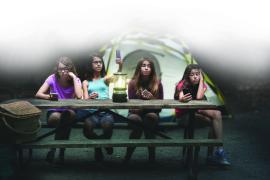We've all been there. We're trying to help or referee some situation with kids, we're told a few things or parts of the story, and we think we know what happened, so we turn to the kid who we think is at fault and utter some variation of the words, "Go say you're sorry."
Let's be honest about one thing: They are not sorry!
Anyone who is paying even a little attention to what is going on in front of them knows that whatever just happened was intentional. It was said or done on purpose and for a reason. Having said that, the action or behavior is often not malicious or meant to hurt to the level or degree it did, but intent is everything, and they meant to do it. It doesn't even look or sound genuine when they actually apologize, and yet it is somehow acceptable and treated as if it can magically fix the problem.
In fact, some of you just reacted to the idea of apologizing as a "magic" fix because of the powerful nature of genuine apologizing. When we ask campers to apologize, it comes from a good place. We want them to apologize because as adults we know that it often works. Saying, "I'm sorry" is an indirect way of validating someone else's hurt feelings and taking responsibility for our own actions. But seriously, how long have you known how to do that? Aren't you still pretty bad at it? And chances are you get better at it when you either do it sincerely and experience the positive results, or insincerely (or not at all) and experience more negative results. Because most kids are being forced to apologize, they never get an opportunity to experience those positive results. The people to whom they are apologizing know it's disingenuous and forced, so there is the same lack of meaning in their rote response of, "It's OK." Which, by the way, it's not. Being physically hurt or having hurt feelings is not an "OK" state of affairs. Let's teach kids to accept apologies, or even to say "thank you" when someone does apologize, instead of dismissing the original action by saying, "it's OK."
I know that's a minor point, but it's part of the bigger issue of behavior management and problem-solving with kids. As adults, we tend to take over the process. When we do that, we are taking away the chance for kids to learn how to do it on their own, which will perpetuate some of the same bad behavior and poor decision-making.
What's the Point of Behavior Management and Problem-Solving?
"Kids learn how to make good decisions by making decisions, not following directions." I heard my friend Jack Schott say this when he was describing his camp, Camp Stomping Ground, and their philosophy about choice-based programming. It's the perfect answer. Most of the time we think of behavior management and problem-solving in terms of the moment or present experience. Because issues, obstacles, and conflicts get in the way of the best camp experience, there is pressure to fix things so we can get back to having fun. The problem with that is it doesn't teach the campers anything about solving their own problems or making their own decisions. You might want to argue with me and say that at least it's faster and saves a lot of time in the day. But if you can help them learn how to use problem-solving skills, there will be fewer problems, and voila! You have your day back. Besides, they are just like the rest of us; they learn more by doing something than by just hearing about it.
How Do We Do It?
There are a ton of ideas, strategies, and techniques when it comes to working with kids, especially around behavior management and problem-solving. At the core of almost all of them are the basics of problem-solving and decision-making, which can be summarized into three components:
- What's the problem or decision?
- What are some possible solutions or different choices?
- Choose one and see what happens.
There is obviously more to it, but if we start there, it's relatively simple (maybe not easy) to put together some ideas to help kids learn how to do it.
Asking Good Questions and Listening Without Judgment
It all starts with understanding the problem. In most cases, the problem is a combination of the situation at hand, which is what we see or what just happened, and a variety of other factors like the camper's past experience, their relationship with the others involved, how they are feeling at that moment, and so on. The point is when we start problem-solving or decision-making with kids, we really have no idea what they are bringing to the situation. A classic example is seeing a camper do something right in front of you.
Counselor: Hey man, it's not OK to push people. What's going on between you two?
Camper: What? I didn't do anything!
Counselor: What do you mean? I saw you push him.
Camper: No, I didn't!
You know exactly how the rest of the conversation sounds. Sure, you saw him push the other kid. But because of all the other stuff (the underlying issues, preconceived notions, prior experiences, etc.) going into this problem, the camper you are talking to just doesn't see it that way. His experience of the issue is way deeper, so it means more than just pushing. Often, I don't think kids even realize that we are only talking about the one behavior we saw or that was reported to us. Their experience is a part of a whole, not just the moment we witnessed. Because most kids are still learning how to express themselves clearly, and in this moment or situation they are probably feeling hurt and defensive, they can't articulate that more is going on here than just what you happened to catch. So it turns into pleas of innocence and zero acknowledgment of the action. Do you want to know why that was the straw that broke the camel's back? It's the million other straws beneath it.
All of this leads us to the crux of the issue: we have to be better listeners. Because it is almost never strictly about the single behavior (the straw) and kids have a hard time articulating what feelings and issues they are bringing into the situation (the million other straws), we have to ask good questions and listen without judgment. Here are the three best strategies for lending an ear without judging:
- "Tell me more about . . . " There is an art to asking good questions. Good questions get the person talking to say more. The best way to practice this is to listen for one thing that you can paraphrase or restate, and then ask a follow-up question about it. For example:
Reader: I get it! It's helpful to think about just listening for one thing. Are there other strategies for asking good questions?
Author: You definitely get it! Yes, there are . . . - Emojis are meaningful. Why do we send emojis? Most people say that it adds meaning and emotion to your words. Somehow the little red mad face is more expressive and articulate than me saying, "I'm mad." We don't just send emojis, we receive them all the time. Look for and pay attention to "emoji moments" with your campers. They tell you all the time without using words how they are feeling, how interested they are, and if they are comfortable. We just have to "listen" to them.
- Let them be right about whatever they need to be right about. A lot of adults get caught up when they are trying to listen because kids get defensive, and adults feel like they have to respond to them, correct them, or force them to take responsibility. Instead, try to back off in those moments. Just say, "OK" or some other calming (and probably disarming) statement, and then ask another question that is directly about their experience. The more questions we ask about their experience, the more opportunities they will have to describe what is going on (or went on), and the more likely they are to take responsibility for some action or behavior.
Teaching Decision-Making
Working through possible choices is where most adults veer off track and end up telling kids what to do (i.e., "say you're sorry."). The problem is that does very little to teach campers how to make choices and gives them all the reason in the world to deflect responsibility. Instead, ask them what to do. Once you get them talking and they take responsibility for some action, no matter how small or seemingly insignificant to the issue at hand, then you have an opportunity to ask them what they can do about it. You might ask the following questions:
- "What do you think you can do about that?" or "How can you make that right?"
- "And what do you think would happen if you did that" (pros and cons)?
These two ideas create the foundation for learning how to make great choices. When you are asking them what they can do, they will still try to deflect responsibility by describing choices that everyone else, including you, can make. Redirect them back to what they can do, and for every option or choice, help them determine if:
- they can make that choice
- what might happen if they try
- whether it's a better or worse choice than their other options
As you are talking, keep focusing on the possible outcomes of their choices. You are teaching decision-making!
Support Them Trying and Review What Happened
Now you are ready to help them make a different or new choice. By listening to them carefully and supporting them working through potential choices, you have actually transformed yourself in their eyes. You have gone from antagonist to protagonist, villain to hero, or (maybe a little less extreme) the adult they are fighting who doesn't get it, to the adult who is willing to help and support them.
Whatever their choices were, supporting them trying one will look and sound different depending on the camper and situation. Sometimes it will be active, and you may have to mediate a discussion or help negotiate a compromise. Other times, you may want to send them off to try a discussion on their own. The most important part is that you follow up with them to see what happened. Because life is messy, and most of the time there won't be a moment, decision, or choice a camper will make that will magically solve a problem, this review step helps them (and you) figure out what's next. It might be that the effort smoothed over the issue, but the other person is still mad. OK, what's next? It might be that the camper now understands why something is important, but they still feel pressure to do otherwise. OK, what's next? In every iteration, reviewing a choice and what happened because of it will guide your discussion to the "what's next?" phase.
And that, my friends, is teaching actual problem-solving and decision-making.
In real life, there isn't much of an end to problems, conflicts, and issues. We work a little on things, we get marginally better, we face setbacks, we work harder, and maybe we overcome a challenge — only to find another one waiting patiently for us. Camp, in general, and having you as a role model and camp counselor, specifically, can accelerate kids, learning and offer them experience in active problem-solving and decision-making they may not find anywhere else.
Discussion Questions
|
Scott Arizala is a leading expert, trainer, and consultant in summer camp. He is the CEO of The Camp Counselor, a consulting and training company, and the executive director of Chasing Summer, an organization dedicated to creating access for people with autism in recreation and education. He is a pioneering contributor to and project manager of Expert Online Training, a world leader in online training for camp staff. Scott is the author of the best-selling book, S'more Than Camp and contributing editor of Happiness, Diversity & Autism: Practical Strategies for Inclusion.



